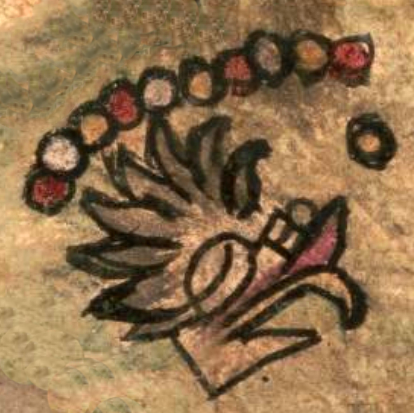Matlactli Once Ehecatl (CQ)
This simplex glyph-plus-notation represents the personal name (a date), Eleven Wind (Matlactli Once Ehecatl, also known as Quetzalecatzin, both in Nahuatl). The name is given in the reverential (with the suffix -tzin) because the man with this name (shown in the contextualizing image) was a ruler. The number eleven consists of a group of ten ones and one more off a bit by itself. These dots are located above the head of a bird (perhaps a quetzal), which is shown in profile looking to the viewer's right. The dots are colored in a pattern of red-white-yellow (or vice versa) that repeats. The white is not a natural paper surface, but actually painted white. The bird's yellowish beak is open, its eye appears to be closed, the feathers on its head are spiky and green, quetzalli feathers, and above the bird's beak is a red protrusion and additional matter above that, recalling Ecatl or Ehecatl (the divine force of the wind), providing the "-ecatzin" part of the name.
Stephanie Wood
Gabrielle Vail and Christine Hernández (Re-Creating Primordial Time, 2013, ) describe Ehecatl as the wind aspect of Quetzalcoatl, and they note that Ehecatl "wears a buccal (duck) mask through which to blow wind." That the "beak" may have been perceived as a blowing device is supported by the glyph for Pitztli (below).
John Montgomery drew a group of wind glyphs (possibly mainly Mixtec), showing the variety of ways the blowing device might look. It is published in FAMSI, Inc.
The text that refers to this person calls him Quetzalecatzin, which more closely approximates the glyph. According to Sebastián van Doesburg (for the citation, see our Bibliography), Quetzalecatzin was a well-known prehispanic governor of Tecamachalco (which is in the modern state of Puebla), who had Popoloca heritage. His father was Cuetzpaltzin, whose governing seat was at Cuauhtepec, on the mesa to the west of present-day Tecamachalco, Puebla. Quetzalecatzin's wife was Chicome Tochtli (Seven Rabbit). Quetzalecatzin was a governing ruler (tlahtoani) who distributed lands and macehuales to his son in Huitziltepec and Todos Santos Xochitlan, also called Ecatepec, in the mid-fifteenth century.
Other images of the divine force of simply the wind (Ehecatl) appear below for the purpose of comparing the beak and other protrusions above the beak of Quetzalecatzin. Ehecatl was a sign in the 260-day divinatory calendar, called the tonalpohualli in Nahuatl. Calendrics held an important place in Mesoamericans' religious view of the cosmos.
Stephanie Wood
covers ruling men and women of Tecamachalco through 1593
Randall Rodríguez and Stephanie Wood
eleven, once, quetzales, names, nombres de hombres, dates, fechas, days, días, numbers, números, birds, wind, viento, feathers, mahtlactli, nombres de hombres, ave, aves, pájaro, pájaros, pluma, plumas, animals, animales

matlac(tli), ten, https://nahuatl.wired-humanities.org/content/matlactli
matlactli once, eleven, https://nahuatl.wired-humanities.org/content/matlactli-once
quetzal(li), quetzal feathers, https://nahuatl.wired-humanities.org/content/quetzalli
eheca(tl), wind, https://nahuatl.wired-humanities.org/content/ehecatl
-tzin (reverential), https://nahuatl.wired-humanities.org/content/tzin
Once Viento, 11-Viento
Sebastián van Doesburg, "El mapa de Ecatepec y Huitziltepec," p. 129
The Codex Quetzalecatzin, aka Mapa de Ecatepec-Huitziltepec, Codex Ehecatepec-Huitziltepec, or Charles Ratton Codex. Library of Congress. https://www.loc.gov/item/2017590521/
The Library of Congress, current custodian of this pictorial Mexican manuscript, hosts a digital version online. It is not copyright protected.







